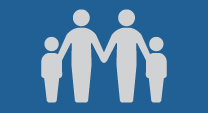Spotlight

Families and households in the UK: 2022
What's in the bulletin?
- In 2022, there were 19.4 million families in the UK, an increase of just over 1 million families (5.7%) in the decade since 2012.
- In 2022, 43% of families (8.3m) had no children living within them, 42% had one or more dependent children (8.2m) and 15% had only non-dependent children (2.9m)
- Married or civil-partnered couple families accounted for the majority of families in 2022 (66%), while cohabiting-couple families accounted for almost 1 in 5 families (19%) and lone-parent families accounted for the remaining 15%.

Children in families in England and Wales: Census 2021
What's in the bulletin?
- In 2021, 12.6 million dependent children lived in households; they were more likely to live in cohabiting couple (not in a marriage or civil partnership) families in 2021 (16.2%) than in 2011 (14.2%), more likely to live in privately rented households in 2021 (23.6%) than in 2011 (19.1%), and more likely to live in multi-generational households in 2021 (5.4%) than in 2011 (4.5%).
- In 2021, there were 781,000 step-families; 547,000 (70.0%) contained dependent children, 51.6% of step-families with dependent children in households of five people or fewer were blended (see Section 3: Glossary), and most step-parents were male (81.6%).
- In 2021, 8.8% (1.1 million) of dependent children lived in step-families, a decrease from 2011 (9.7%, 1.2 million); they were 3.5 times more likely to live in a cohabiting couple family (48.6%) than those living in non step-families (13.3%).

Children whose families struggle to get on are more likely to have mental disorders
Healthy family functioning and parental mental health are important elements in understanding the mental health of children.
Datasets related to Families
-
Households by type of household and family, regions of England and GB constituent countries
Labour Force Survey (LFS) estimates including measures of uncertainty of the number of households by types of household and families, for regions of England and also Scotland and Wales.
-
Young adults living with their parents
Total number of young adults aged 15 to 34 years and total number of young adults aged 20 to 34 years in the UK living with their parents.
-
Families and households
Families and children in the UK by family type including married couples, cohabiting couples and lone parents. Also shows household size and people living alone.
-
Families by family type, regions of England and UK constituent countries
Labour Force Survey (LFS) estimates including measures of uncertainty of the number of families by specific family types, for regions of England and also Scotland, Wales and Northern Ireland.
-
Impact of reweighting on the families and households estimates
Revisions have been made to previously published estimates of families and households. This describes these changes and their impact on the estimates.
-
Living alone in the UK
Data supporting the article “The cost of living alone”
Publications related to Families
Statistical bulletins
-
Children in families in England and Wales: Census 2021
Dependent children in households including in step-families and blended families, multi-generational households, and households with three or more children.
-
Families and households in the UK: 2022
Trends in living arrangements including families (with and without dependent children), people living alone and people in shared accommodation, broken down by size and type of household.
Articles
-
Kinship care in England and Wales
Detailed characteristics of children living in households without their parents but with other relatives in 2021.
-
2011 Census analysis
Using 2011 Census data, we look at residents living in overcrowded and under-occupied households and their general health. Results show residents living in overcrowded households reported significantly higher levels of “not good” health compared with those living in under-occupied households. Young people (aged 0 to 15) were more than twice as likely to report “not good” health if they lived in overcrowded households.
-
2011 Census analysis
We analyse the characteristics of those living alone within the household population aged 16 and over, and the broader usually resident population. Characteristics analysed include age and sex, housing, qualifications and ethnicity. Geographical variations of those living alone are also highlighted. In 2011, 13% of the total usually resident household population of England and Wales were living alone. This is similar to the overall proportion of those living alone within the European Economic Area (EEA) at 14%.
Methodology related to Families
Find, compare and visualise statistics about places within the United Kingdom.
